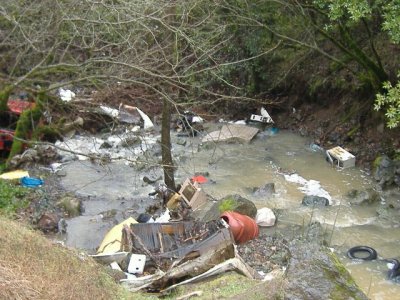LAKE COUNTY – Two local school districts hope to receive money from a state fund set aside to help improve academic quality and increase teacher training.
Last September Gov. Arnold Schwarzenegger signed SB 1133, which establishes the Quality Education Investment Act (QEIA) of 2006.
The legislation arose out of the terms of a settlement between the California Teachers Association (CTA) and Schwarzenegger. CTA sued the governor over Proposition 98 monies that were due to state schools, but not paid, in the 2004-05 and 2005-06 school years.
Using the $3 billion in Proposition 98 funds, QEIA seeks to assist the state's lowest performing schools in increasing student achievement.
Schools whose 2005 Academic Performance Index (API) are ranked in deciles 1 to 2 – which is the lowest 20 percent – are eligible for the funds.
County schools that are eligible to apply for funds are Upper Lake High School, and in the Konocti Unified School District, Pomo Elementary, Burns Valley Elementary and Oak Hill Middle School, reported Patrick Iaccino, principal and superintendent of Upper Lake High, and Dr. Louise Nan, superintendent of the Konocti Unified School District.
The California Department of Education (CDE) reports that the appropriations begin in fiscal year 2007-08 and continue through 2013-14. School districts around the state will receive approximately $268,000,000 in fiscal year 2007-08 and $402,000,000 for each fiscal year thereafter until 2013-14.
“We've been told it's an experiment the state is doing to see if higher levels of funding can actually make a difference in schools,” said Nan.
Iaccino attended a conference in Sacramento in January to find out more about the funding.
He reported that 1,470 schools statewide – elementary, middle and high schools – are eligible, with 400 of those schools located in the Los Angeles Unified School District alone.
Chris Thomas, Lake County Office of Education's assistant superintendent of educational services, also attended the QEIA conference.
She explained that not all schools will receive funds, but that the state has guaranteed that each county will have at least one school funded through a lottery process. Thomas added that state officials have said that 30 percent of the schools that apply will receive money.
Thomas said the money must be used for very specific reasons, including lowering class sizes, lowering the ratio of students to credentialed counselors (in high schools), increasing numbers of qualified teachers, and offering more teacher training and development.
All of that effort, she said, is meant to result in increased student achievement.
Iaccino said for Upper Lake High, the school would be eligible for between $400,000 and $450,000 annually, or between $2.8 million and $3.1 million.
Compare that with the school's overall annual budget, which Mike Casey, business management for the Lake County Office of Education, reported is $4.7 million.
Funds in the 2007-08 school year would be earmarked for facilities, Iaccino said, in order to reduce class sizes.
Applications for the funds must be completed by the end of March, Iaccino said. The school is also in the process of formulating a plan for how the money would be spent, he said.
For districts with more than one school applying, the district must prioritize which schools it wants to see receive the money. “We don't have to worry about that,” he said.
KUSD has three schools eligible, said Nan. “We're going to apply for the funding for all three schools,” she said.
However, they've had to prioritize because it's unlikely all three schools would receive the money, she said.
“Our first priority right now is Oak Hill Middle School, then we'll be taking a look at the elementary schools in a different order,” she said.
Oak Hill, said Nan, is in year four of its program improvement status, which the No Child Left Behind Act requires for those schools that don't make adequate yearly progress. The district, she said, is in the process of looking at restructuring Oak Hill in response to government guidelines.
Second in line would be Pomo Elementary, said Nan, followed by Burns Valley, which already has a high priority schools grant.
If Oak Hill was funded, it would receive $352,800 in the first year and $533,000 annually for the following six years, amounting to nearly $3.5 million.
The district's overall budget is $29 million, said Casey.
The grant, said Nan, “would be a significant funding source.”
Nan said the state is very clear that the money must be used for class size reduction. In grades fourth through eighth, she said, the goal is to have a ratio of 25 students to one teacher. Most of the money would be directed toward the increase in personnel costs to meet that ratio, she said.
Iaccino said the funds – $2.8 to $3.15 million over seven years – could help with textbooks and supplemental materials, as well as adding teachers and counselors to serve the school's 430 students. “It gives you so many options to do some of the things you need to do to help kids,” he said.
Thomas said the money will be available for seven years, but there's no guarantee from the state that there will be additional help to maintain staff levels or programs once the money runs out.
Schools will need to do a plan for ramping down eventually, Thomas said. “There's hope that there might be more money to follow this, but there's no guarantee.”
Nan said KUSD will need a plan that looks at how to meet those costs after the funding runs out.
Iaccino said Upper Lake High will definitely seek the funds. “It'll be interesting to see how it unfolds,” he said.
E-mail Elizabeth Larson at This email address is being protected from spambots. You need JavaScript enabled to view it.
{mos_sb_discuss:2}

 How to resolve AdBlock issue?
How to resolve AdBlock issue? 








